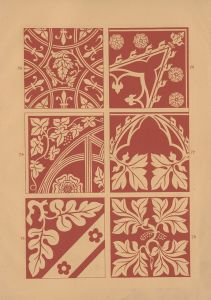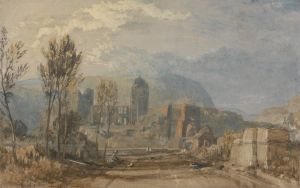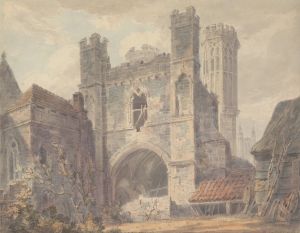
Interior of St. John’s Palace, Eltham
A hand-painted replica of Joseph Mallord William Turner’s masterpiece Interior of St. John’s Palace, Eltham, meticulously crafted by professional artists to capture the true essence of the original. Each piece is created with museum-quality canvas and rare mineral pigments, carefully painted by experienced artists with delicate brushstrokes and rich, layered colors to perfectly recreate the texture of the original artwork. Unlike machine-printed reproductions, this hand-painted version brings the painting to life, infused with the artist’s emotions and skill in every stroke. Whether for personal collection or home decoration, it instantly elevates the artistic atmosphere of any space.
Joseph Mallord William Turner, one of the most renowned British painters of the 19th century, is celebrated for his expressive colorization, imaginative landscapes, and turbulent marine paintings. Among his extensive body of work is the painting "Interior of St. John’s Palace, Eltham," which reflects his fascination with architectural subjects and historical themes.
Turner was born in 1775 in London and demonstrated artistic talent from a young age. He was enrolled at the Royal Academy of Arts at the age of 14, where he quickly gained recognition for his skill in both watercolor and oil painting. Throughout his career, Turner was known for his innovative approach to capturing light and atmosphere, which would later influence the Impressionist movement.
"Interior of St. John’s Palace, Eltham" is a testament to Turner's ability to blend architectural precision with atmospheric effects. Eltham Palace, located in the Royal Borough of Greenwich, London, has a rich history dating back to the 14th century. It was once a royal residence, frequented by monarchs such as Edward II and Henry VIII. By the time Turner painted it, the palace had fallen into a state of romantic decay, which likely appealed to his artistic sensibilities.
The painting captures the grandeur of the palace's interior, focusing on the intricate details of its Gothic architecture. Turner’s use of light and shadow in the painting highlights the structural elegance of the palace, while also creating a sense of mystery and nostalgia. The interplay of light streaming through the windows and the resulting shadows cast across the stone floors and walls is a hallmark of Turner's style, demonstrating his mastery in depicting the effects of light.
Turner's choice of subject matter in this painting reflects the 19th-century Romantic interest in the sublime and the picturesque, where ruins and historical architecture were seen as symbols of the passage of time and the transience of human achievements. The painting invites viewers to reflect on the history encapsulated within the walls of Eltham Palace and the stories they might tell.
While "Interior of St. John’s Palace, Eltham" is not as widely known as some of Turner’s other works, such as "The Fighting Temeraire" or "Rain, Steam, and Speed," it remains an important piece within his oeuvre for its architectural focus and atmospheric depth. It exemplifies Turner's ability to convey emotion and narrative through his depiction of space and light.
Turner’s legacy as a pioneer of landscape painting and his influence on future generations of artists cannot be overstated. His works continue to be studied and admired for their technical brilliance and emotional impact. "Interior of St. John’s Palace, Eltham" is a fine example of his skill in capturing the essence of a place, blending historical reverence with artistic innovation.

















